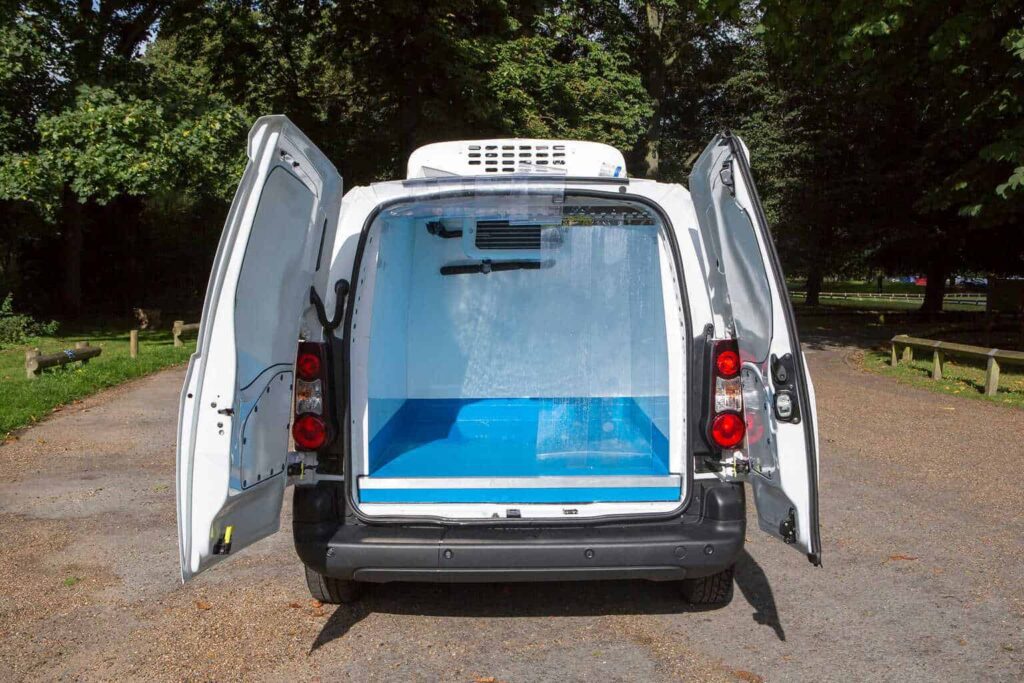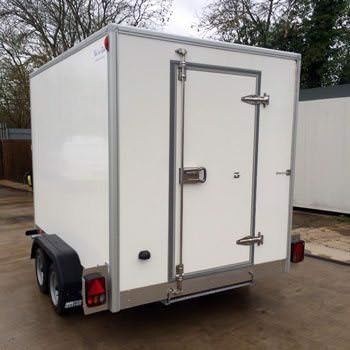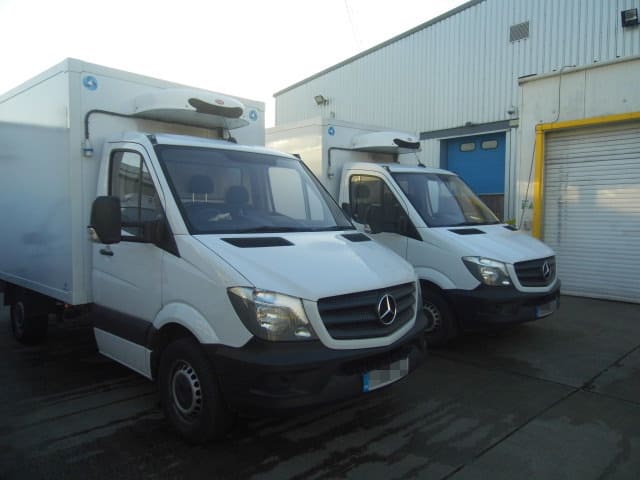Refrigerated vans are essential for transporting perishable goods, ensuring they arrive fresh and intact. Loading your van effectively is crucial to maximise efficiency and maintain product quality. This guide provides eight comprehensive tips to help you optimise your refrigerated van’s capacity while ensuring safety and compliance with regulations.
Proper organisation of your refrigerated van is vital for several reasons. Efficiently using space helps maintain the quality of perishable items and ensures the safety of your goods during transit. The process begins with understanding the specifics of your load and space requirements. Different products have varying temperature needs; understanding these will help you allocate space more effectively. Additionally, knowing the dimensions and weight of your goods aids in strategic placement, avoiding unnecessary rearrangement and minimising the risk of damage.
1. Loading Plans
Pre-Plan Load
Before you begin loading, create a detailed plan. Consider the order in which deliveries will be made and the ease of access required for each item. This pre-planning phase saves time and reduces the risk of mishandling goods. For instance, items scheduled for the last delivery should be loaded first and placed at the back of the van, ensuring that those for the first delivery are easily accessible. A well-thought-out plan can prevent unnecessary delays and helps maintain the integrity of the goods.
Use of Pallets
Utilising pallets can streamline the loading and unloading process. Pallets allow for easier handling of bulk items, ensuring they are stacked securely and can be moved with minimal effort. They also facilitate better airflow around the products, maintaining consistent temperatures. Pallets come in various sizes and materials, and choosing the right type can significantly impact the efficiency of your loading process. Wooden pallets are durable and reusable, while plastic pallets are lighter and easier to clean, which can be beneficial for maintaining hygiene standards.
Quick Access Points
Consider the design of your van and how it affects access to your load. Side and roll-up doors provide quick access points, allowing faster loading and unloading. This feature is handy for multiple deliveries, reducing the time your van doors are open and maintaining the internal temperature more effectively. Quick access points can also improve safety by reducing the time spent outside the vehicle, especially in high-traffic areas or adverse weather conditions.
2. Strategic Loading
Avoid Overloading
Overloading your van can lead to several issues, including increased fuel consumption, higher risk of accidents, and damage to the van’s suspension. Adhere to the manufacturer’s weight limits to ensure safe and efficient operation. Overloading puts your goods at risk and can incur legal penalties and increase maintenance costs due to the strain on the vehicle. It is crucial to weigh your load accurately and distribute it according to the van’s specifications.
Operations Director, Craig Diaz, of FridgeXpress explains, “It is tempting to believe that you can get away with a smaller van or a single journey. The risks are too great, not only to your reputation when you are found to be breaking the law, but in the quality of service you might offer.”
Even Distribution
Distribute weight evenly across the van to maintain balance and stability. Uneven loads can cause handling issues and increase wear and tear on your vehicle. Proper weight distribution also ensures better fuel efficiency and minimises the risk of product damage. When loading, place the heaviest items on the bottom and centre of the van, with lighter items on top and towards the sides. This practice helps maintain the van’s centre of gravity, enhancing driving safety.
3. Adjustable Shelves
Flexibility and Accessibility
Adjustable shelves offer flexibility in organising different types of products. They allow you to customise the van’s interior space to fit varying sizes of goods, making it easier to access items without moving other products around. This adaptability is particularly useful for businesses transporting many items, from small packages to large boxes. Shelving systems can be reconfigured quickly, enabling efficient use of space and reducing loading and unloading times.
Heavy-Duty Racks
Invest in heavy-duty racks for durability and stability. These racks can support heavier items and withstand the rigours of transit, ensuring your goods remain securely in place. Heavy-duty racks are typically made from robust materials such as steel, which can endure significant weight and repeated use. Additionally, these racks can be designed with features like anti-slip surfaces and locking mechanisms to secure your load further.
4. Utilise Insulated Containers and Bins
Using insulated containers and bins helps maintain the temperature of sensitive products. They provide an additional layer of protection, ensuring that items stay within their required temperature ranges even if the van doors are opened frequently. Insulated containers are particularly beneficial for transporting products that require strict temperature control, such as pharmaceuticals and frozen foods. These containers come in various sizes and can be stacked or nested to optimise space.
There are various types of containers and cooling materials. These include:
- Coolers and Ice Chests
- Description: Coolers and ice chests are portable insulated containers commonly used for short-term storage and transportation.
- Materials: Typically made from hard plastic or metal with foam insulation.
- Use Cases: Ideal for transporting perishable goods, beverages, and food items over short distances. They are commonly used in catering and outdoor events.
- Insulated Boxes
- Description: These are rigid, box-like containers with thick insulation to maintain internal temperature.
- Materials: Usually constructed from expanded polystyrene (EPS), polyurethane (PU) foam, or vacuum-insulated panels (VIPs) with a plastic or metal outer shell.
- Use Cases: Suitable for longer-distance transport of sensitive items such as pharmaceuticals, seafood, and dairy products.
- Thermal Bags
- Description: Flexible, lightweight bags with insulated linings, often used for short-term transportation.
- Materials: Made from materials like polyester or nylon with insulated foam linings or thermal reflective layers.
- Use Cases: Commonly used by food delivery services and individuals for transporting meals, groceries, and beverages.
- Insulated Pallet Covers
- Description: Large insulated covers that fit over pallets to maintain the temperature of bulk goods.
- Materials: Typically made from materials like reflective foil, foam, and plastic.
- Use Cases: Used in logistics to protect large shipments of temperature-sensitive goods such as chemicals, pharmaceuticals, and fresh produce.
- Passive Temperature-Controlled Containers
- Description: Advanced insulated containers designed to maintain temperature without an active cooling mechanism.
- Materials: Phase change materials (PCMs) or advanced insulation like vacuum-insulated panels (VIPs) are often used.
- Use Cases: Ideal for long-distance transportation of highly sensitive goods, including medical supplies, biological samples, and certain foods.
- Gel Packs and Ice Packs
- Description: These are not containers themselves but are often used within insulated containers to provide additional cooling.
- Materials: Contain gel or liquid that can be frozen and placed alongside goods within insulated containers.
- Use Cases: Enhance the cooling capability of insulated containers, particularly for items that need to remain below a specific temperature for extended periods.
- Dry Ice Containers
- Description: Specialised containers designed to hold dry ice for ultra-cold transportation needs.
- Materials: Made from materials that can withstand extremely low temperatures, often with thick walls for added insulation.
- Use Cases: Transporting items that require very low temperatures, such as certain pharmaceuticals, biological samples, and frozen foods.
- Insulated Totes
- Description: Mid-sized containers with insulated walls and lids, often used for organised transport within a larger vehicle.
- Materials: Usually made from plastic with foam insulation or other insulating materials.
- Use Cases: Commonly used for grocery deliveries, transporting prepared foods, and other medium-sized loads that require temperature control.
Each type of insulated container serves specific purposes and offers unique advantages depending on the nature of the goods being transported, the distance, and the required temperature range. Selecting the appropriate type of container is crucial for maintaining product integrity and ensuring efficient, safe transportation.
5. Labelling
Clear and Visible Labels
Label all items clearly and visibly. This practice helps quickly identify products, reducing the time spent searching for specific items during deliveries. Clear labelling is essential for efficient inventory management and can prevent mix-ups, ensuring that each delivery is accurate. Labels should include important information such as product name, destination, and handling instructions.
Colour-Coding
Implement a colour-coding system to streamline inventory management. Different colours can represent different product categories or destinations, simplifying the loading and unloading. Colour coding is beneficial when handling many items, as it allows for quick visual identification and reduces the risk of errors. For example, blue labels could indicate frozen goods, while green labels could represent fresh produce.
6. Inventory Management
Use an Inventory Management System
Use an inventory management system to track your stock. This can help prevent overloading and ensure that you always clearly understand what’s in your van. An adequate system can provide real-time updates on stock levels, locations, and expiry dates, facilitating efficient route planning and reducing waste.
First-In, First-Out (FIFO)
Adopt the FIFO method to ensure that older stock is used first. This practice helps in maintaining the freshness of your products and reduces waste. FIFO is essential for perishable goods, as it ensures that items are used within their optimal time frame, minimising the risk of spoilage.
Digital Systems
Consider digital labelling and tracking systems for more precise inventory control. These systems can provide real-time updates and reduce human error. Digital systems can integrate with your inventory management software, allowing for seamless tracking and management of your stock. They can also provide valuable insights into usage patterns and help forecast demand.
7. Secure Load
Straps and Nets
Use straps and nets to secure your load. These tools prevent items from shifting during transit, reducing the risk of damage. Straps and nets are available in various sizes and strengths, and choosing the right ones can ensure that your goods remain stable and secure. Regularly check the condition of these securing tools and replace them as needed to maintain their effectiveness.
Non-Slip Mats
Place non-slip mats on the van floor to provide additional stability for your goods. These mats help keep items in place, especially during sudden stops or sharp turns. Non-slip mats are beneficial for securing smaller items that might otherwise shift or slide during transit. They are easy to clean and can be cut to fit any space.
Safety Equipment
Ensure your van has the necessary safety equipment, including protective gear and emergency kits. This preparation is crucial for handling unexpected situations on the road. Safety equipment should include items like fire extinguishers, first aid kits, reflective vests, and warning triangles. Regularly inspect and replenish your safety equipment to ensure it is always ready.
8. Train your team
Comprehensive Training Programmes
As Craig Diaz, of FridgeXpress notes, “Your team are your most important resource when it comes to effective logistics. You can sleep at night if your people are well-trained and encouraged to deploy the best practices.”
Here are the areas where you must ensure your team is compliant and highly competent.
Loading Techniques
Train your staff on effective loading techniques. Proper training ensures that everyone knows how to handle goods correctly, minimising the risk of damage. Training should cover topics such as weight distribution, securing loads, and using equipment like pallets and racks. Practical, hands-on training sessions can help staff understand and apply these techniques effectively.
Emergency Procedures
Educate your team on emergency procedures. This includes what to do in case of a vehicle breakdown or an accident, ensuring that the staff and the goods are safe. Emergency procedures should cover steps to secure the load, contact emergency services, and communicate with the dispatch team. Regular drills and refresher courses can help keep these procedures in mind.
Continuous Improvement
Encourage continuous improvement through feedback loops and regular reviews. Assess your loading processes regularly and make necessary adjustments to enhance efficiency. Solicit feedback from drivers and loaders to identify areas for improvement and implement changes that can streamline operations and improve safety.
Technology Integration
Incorporate technology into your training programmes. Use simulations and digital tools to provide hands-on learning experiences, making it easier for staff to grasp complex loading techniques. Virtual reality (VR) and augmented reality (AR) tools can simulate real-world scenarios, allowing staff to practise and refine their skills in a controlled environment.
Health and Safety Standards
HACCP Compliance
Ensure your loading practices comply with Hazard Analysis and Critical Control Points (HACCP) standards. This is crucial for maintaining food safety and quality during transport. HACCP compliance involves identifying potential hazards, implementing controls, and monitoring processes to ensure food safety. Regular audits and inspections can help maintain compliance and improve food safety practices.
Vehicle Regulations
Adhere to all vehicle regulations, including weight limits and licensing requirements. Compliance with these regulations ensures that your van operates legally and safely. Regulations vary by region, so staying informed about local requirements and ensuring that your van and drivers meet all necessary standards is essential.
Weight Limits
Always respect the weight limits specified for your van. Overloading can lead to penalties and increase the risk of accidents, compromising the safety of your load and the driver. Use calibrated scales to weigh your load accurately and ensure you do not exceed the van’s capacity.
Licensing
Ensure that all drivers have the appropriate licences for operating a refrigerated van. This includes any special endorsements needed for handling specific types of goods. Regularly review and update your drivers’ training and certifications to ensure they comply with current regulations.
Conclusion
Effective loading of a refrigerated van involves strategic planning, proper equipment, and comprehensive training. These eight essential tips can maximise your van’s capacity, maintain product quality, and ensure safe transportation. Remember, a well-organised refrigerated van protects your goods and enhances efficiency and compliance with industry standards.
Loading is one element of successful van management. You may also explore these additional tips on effectively running a refrigerated van.
Additional Tips:
- Regular Maintenance: Keep your refrigerated van well-maintained to ensure it operates efficiently. Regularly check the refrigeration unit, insulation, and vehicle engine to avoid unexpected breakdowns.
- Monitor Temperature: Use temperature monitoring systems to keep track of the internal temperature of your van. These systems can alert you to deviations from the set range, allowing you to take corrective action promptly.
- Optimise Routes: Plan your delivery routes to minimise travel time and fuel consumption. Efficient routing saves costs and helps maintain the quality of your perishable goods by reducing time spent in transit.
- Customer Feedback: Gather feedback from customers about the condition of goods upon delivery. This information can provide insights into potential issues with your loading and transportation processes, allowing you to make necessary adjustments.
- Sustainability Practices: Consider adopting eco-friendly practices, such as using energy-efficient refrigeration units and reducing packaging waste. Sustainable practices can enhance your brand reputation and contribute to environmental conservation.
By implementing these additional tips and continuously improving your loading and transportation processes, you can achieve greater efficiency, cost savings, and customer satisfaction in your refrigerated van operations.
If you would like to learn more about refrigerated vans and how we drive best practices, contact us at sales@fridgexpress.com



